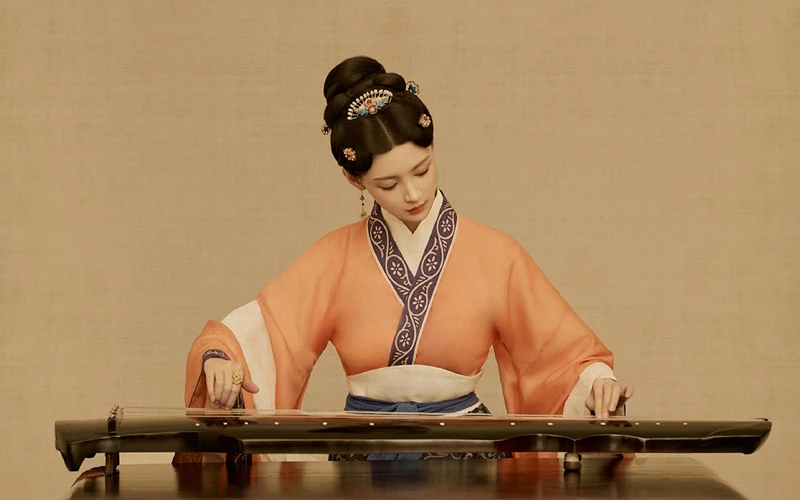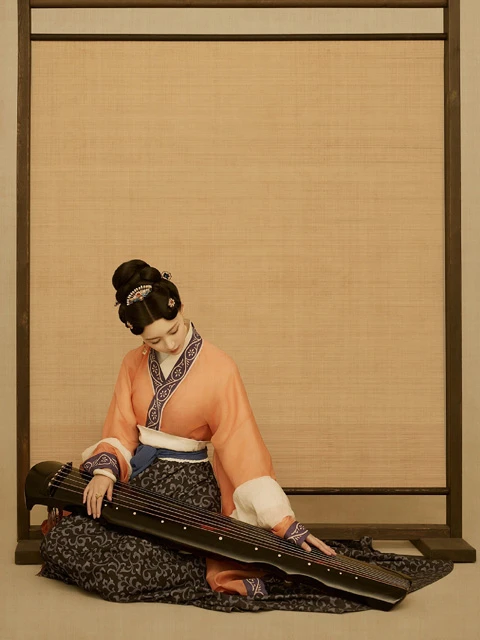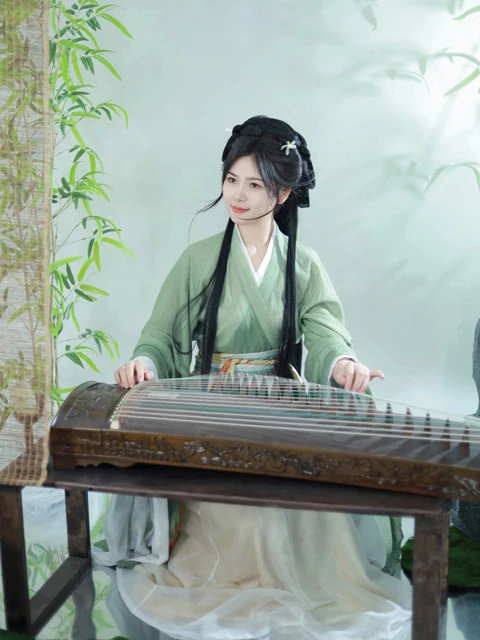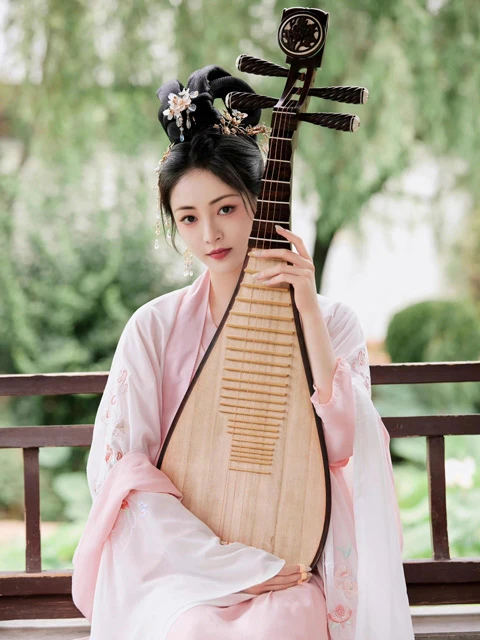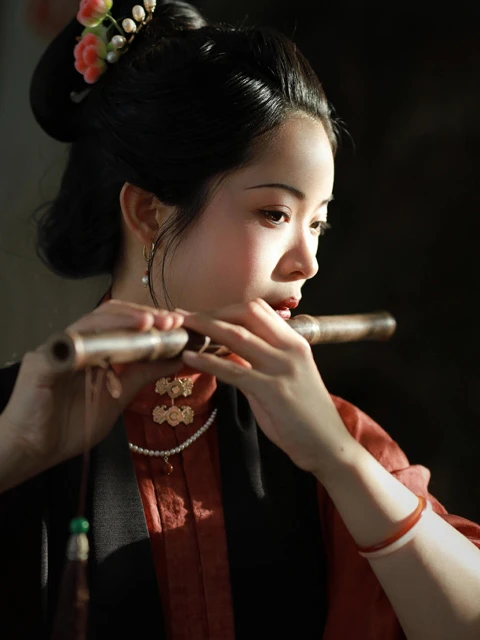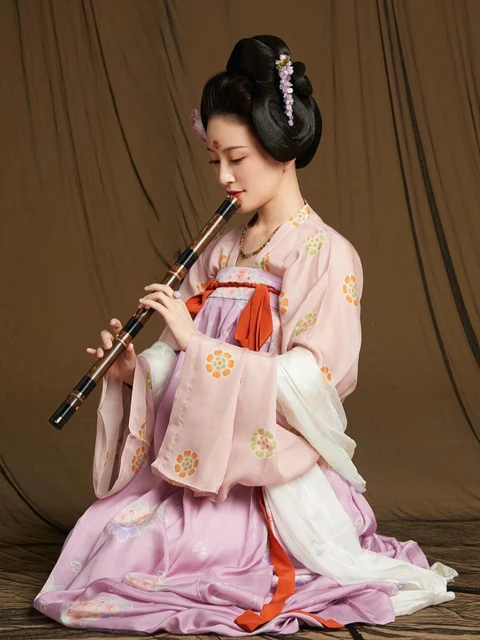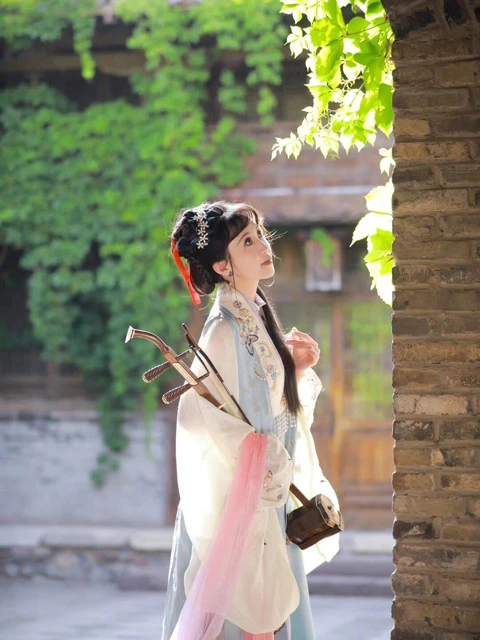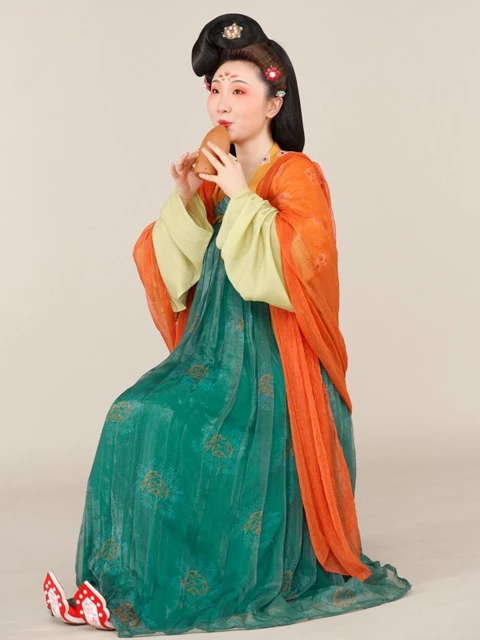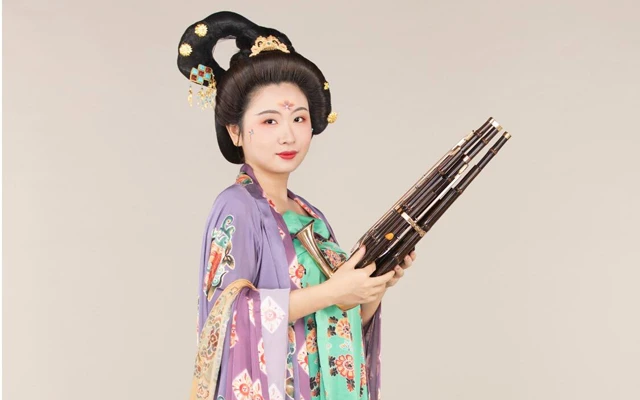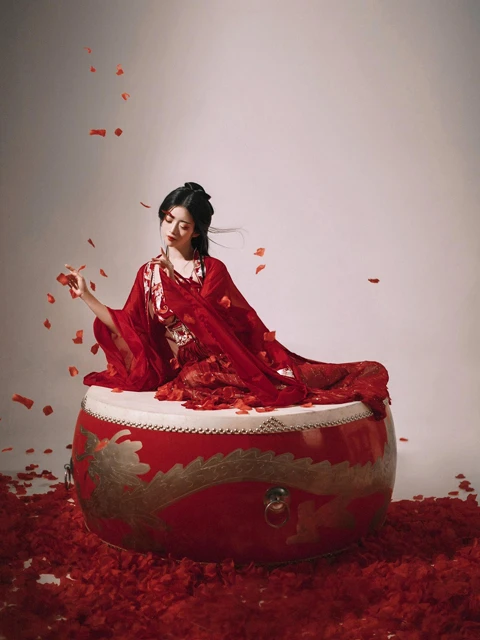In the rich cultural heritage, Hanfu and traditional Chinese instruments are not just symbols of China's long history; they are also bridges that combine modern aesthetics with traditional charm. This article will guide you through how to integrate nine typical Chinese traditional musical instruments into the art of Hanfu photography, showcasing their unique cultural significance and visual impact. From the tranquil elegance of the Guqin to the flutes, each musical instrument can add a unique charm to Hanfu.
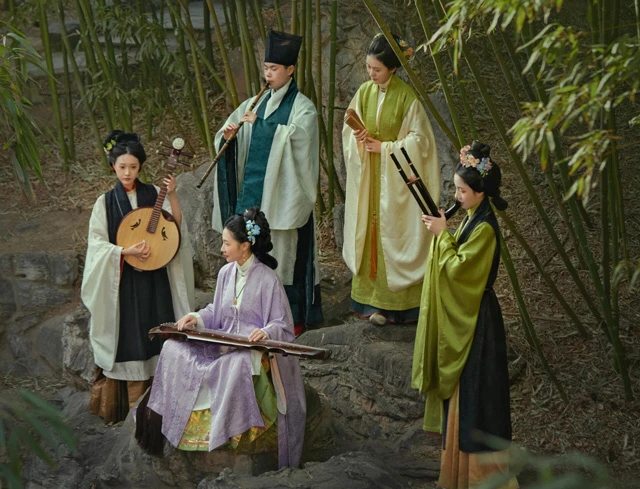
1 - Guqin
The Guqin, also known as the Yaoqin, Yujin, or Seven-stringed zither, is a traditional Chinese plucked string instrument with a history of over three thousand years. The Guqin has a wide range of tones, deep timbre, and lingering resonance.
It is recorded in ancient texts that Fu Xi made the qin, and there are legends of Shennong, the Yellow Emperor, Tang Yao, among others, being involved in the creation of the instrument. Emperor Shun set the qin to have five strings, King Wen added one string, and King Wu defeated King Zhou and added another string to make it seven strings. This demonstrates the long-standing and profound cultural heritage of the ancient Chinese Guqin.
There are over 3360 surviving Guqin pieces, more than 130 music scores, and 300 Guqin songs. On November 7, 2003, the UNESCO World Heritage Committee declared the Chinese Guqin as a World Cultural Heritage. In 2006, it was included in the list of China's Intangible Cultural Heritage.
2 - Guzheng
The Guzheng, also known as the Hanzheng, Qinzhen, Yaozheng, or Luanzheng, is a traditional Chinese plucked string instrument of the Han ethnic group, belonging to the category of plucked instruments. It is one of the unique and important Chinese instruments. With its beautiful tones, wide range, rich performance techniques, and strong expressive power, the Guzheng is deeply loved by the masses.
Nowadays, there are variations such as the Mini Guzheng, Portable Guzheng, and the Semi-Guzheng. The Guzheng is a musical instrument that has accompanied the long-standing Chinese culture, growing on this fertile land of ancient ethnic instruments.
3 - Pipa
The Pipa is a traditional plucked string instrument in East Asia with a history of over two thousand years. The earliest instrument referred to as "Pipa" is believed to have appeared during the Qin Dynasty in China. "Pipa" means "two pieces of jade colliding, producing a pleasant clashing sound," indicating that this is an instrument that produces sound by plucking the strings.
It is made of wood or bamboo and has a semi-pear-shaped with four strings originally made of silk but now mostly made of steel wire, steel rope, or nylon. The neck and the faceplate are marked with "Xiang" and "Pin" to determine the notes. Pipa, it is an important traditional instrument that can be played solo, as an accompaniment, in an ensemble, or in a group performance.
4 - Flute
The Flute is an ancient Han ethnic instrument and one of the most representative and distinctive wind instruments in Han ethnic music. It is one of the commonly used transverse bamboo wind instruments in traditional Chinese music, with varieties such as the Southern Qu Di, Northern Bang Di, and the Middle-range Di. Its range generally spans over two octaves.
The Flute is commonly used in Chinese folk music, operas, Chinese ethnic orchestras, Western symphony orchestras, and modern music, making it one of the iconic instruments in Chinese music. In ethnic music ensembles, the Flute plays a pivotal role as a representative wind instrument in ethnic wind music. Most flutes are made of bamboo, but there are also flutes made of stone, jade, and redwood, and in ancient times, bone flutes were also used. However, bamboo remains the best material for making flutes due to its superior sound quality and lower production cost.
5 - Xiao
The Xiao, divided into the Dong Xiao and the Qin Xiao, both single-tube vertical flutes, is an ancient Han Chinese wind instrument. The Xiao has a long history, with a round and soft tone, quiet elegance, suitable for solo and ensemble performances. It is usually made of bamboo, with finger holes at the top.
Differentiated by the number of "tone holes," it can be a six-hole Xiao or an eight-hole Xiao. The six-hole Xiao has five front holes and one back hole, while the eight-hole Xiao has seven front holes and one back hole. The eight-hole Xiao is a modern improvement.
6 - Erhu
The Erhu is one of the main bowed string instruments in the Chinese musical instrument family, originating in the Tang Dynasty and having a history of over a thousand years. The term "Huqin" appeared in the Tang Dynasty, referring to various Western and Northern ethnic groups as "Hu people," and the Huqin became a general term for musical instruments introduced by Western and Northern ethnic groups.
By the Ming and Qing Dynasties, the Huqin had spread throughout the country, becoming a major accompanying instrument for folk operas and ensemble performances, as well as a general term for friction string instruments.
7 - Xun
The Xun is an ancient clay wind instrument, circular or oval in shape, with six holes. The origin of the Xun is related to the labor and production activities of the ancient Han people. Initially, it may have been made by the ancient people imitating the sounds of birds and animals to lure prey.
With social progress, it evolved into a simple musical instrument and gradually added tone holes, developing into a melodic instrument that can play tunes. The Xun is a mid-range wind instrument, known for its simple and mellow tone, contrasting with the high-frequency tones commonly used by ancient people, making it particularly esteemed. Its inherent rustic and melodious quality is often used by literati as a farewell melody.
8 - Sheng
The Sheng is a reed instrument originating from China, the world's earliest free-reed instrument, producing sound through reeds in each pipe. It is the only harmonic instrument among wind instruments and the only one capable of producing sound by both blowing and sucking. Its clear and bright tone, wide range, and strong expressiveness make it unique.
In traditional instrumental music and Kunqu opera, the Sheng is often used as an accompaniment to other wind instruments such as flutes and suona, adding pure fourth or fifth harmonies to the melody. In modern Chinese orchestras, the Sheng can play both melodic and accompanying roles.
9 - Drum
The drum is an ancient percussion instrument. According to historical records, the origin of the drum can be traced back to the ancient legend of the Yellow Emperor using the hide of a mythical creature called "Kui" to make a drum. It is said that during the battle when the Yellow Emperor defeated Chi You, "the sound of the drum could be heard five hundred li away." Kui was a mythical one-legged creature. Descendants later believed that Kui was actually a giant crocodile, and the tough crocodile skin, when made into a drum, might not have been able to produce sound heard five hundred li away, but it would definitely have been very loud when struck.
In ancient times, drums were revered as instruments capable of communicating with the divine, primarily used for sacrificial purposes. In hunting and military activities, drums were widely employed. The drum as a musical instrument emerged during the Zhou Dynasty, where it held a prominent position among the eight sounds. In ancient texts, the phrase "Gu, qin, se" indicates that before the Qin and Se were played, the drum's sound served as an introduction.
Through the introduction in this article, we can easily see that the combination of Hanfu and traditional musical instruments is not merely a visual pairing; it is a profound cultural experience that goes deep into the marrow. This unique form of photographic art allows us to glimpse into the aesthetic tastes and spiritual world of ancient people. Hopefully, this photography style full of historical and artistic sense can inspire more creativity, enabling more people to experience the boundless charm of Chinese traditional culture through the lens.
